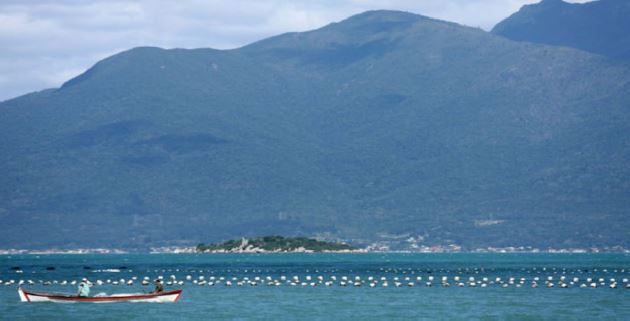6 Environmental Monitoring
The environmental monitoring can be understood as a data collection process and continuous and systematic monitoring of environmental variables, in order to identify and evaluate qualitatively and quantitatively the conditions of natural resources and environmental trends in a predefined time scale. In addition to identifying trends, the results must as far as possible, provide a database for projections of future developments.
The UNEP (United Nations Environment Programme World Conservation Monitoring Centre, 2006) explains that monitoring is an activity that involves repeated observation, according to a predetermined schedule of one or more elements of the environment so that you can detect its characteristics and trends. The tracking therefore provides tangible information on past and present environmental conditions within a regular database. In addition to the environmental information, monitoring systems can also collect social and economic information that is relevant to the systemic understanding of environmental issues.
Before deploying a monitoring system it is critical to have a coordinated and strategic vision (Department of Climate and Industry, 2011):
• What needs to be monitored;
• How the different monitoring systems work together;
• How the information will be communicated; and
• How will the monitoring results be used.
With this plan in mind, environmental monitoring becomes a source of critical information essential to evaluate the current state of the environment, to predict potential impacts and prevent them, and to develop sound strategies for environmental management, and to assist in decision making.
According to Woerden et al. (2014), these systems can be developed for various purposes, such as:
• to evaluate the quality of the local environment, and to promote local awareness of the environment;
• to determine compliance of a certain activity with national and international standards;
• to assess population exposure to pollution, and the impact on human health that such exposure may cause;
• to identify potential threats to the natural environment and to develop contingency systems and risk/ disaster prevention;
• to identify sources of pollution that may harm the multiple uses of aquatic environments by offering the same control measures;
• to provide information for planning and executing environmental management and planification; and
• to support the development of public policy, management tools and the determination of environmental priorities.
So that aquaculture can grow without environmental impacts becoming significant enough to impair production and the environment, it is necessary to elaborate measures of planification, control, recovery, environmental preservation and conservation, through instruments that allow the maintenance of natural resources in their ideal conditions.
The main bottleneck in the set water monitoring initiatives in Brazil, and also in the world, is the lack of integration between existing databases, as well as the methodologies used between continental and oceanic systems. It is of utmost importance that the environmental monitoring of these areas aligned, and that water systems are seen in a systematic and integrated way. Environmental management for aquaculture parks can consist of the following programs:
• Water quality monitoring.
The monitoring of water quality should take into account the CONAMA Resolution No. 413/2009.
The parameters set for this resolution represent the very least that should be monitored for compliance with environmental permitting conditions of an aquaculture park.
• Solid Waste Residue Management Plan.
The Solid Waste Management Plan should be developed through actions that prioritize the sustainable management of waste from the parks.
It is important to follow recommendations to reduce the generation of waste and to determine their management and arrangement, in order to minimize environmental impacts. In the case of clam harvesting, for example, the generation of shells is substantial. These may have an alternative and sustainable destination, such as the building materials industry, and even handicrafts, generating income for the communities.
• Environmental Education Programme.
To raise awareness of aquaculture producers, it is necessary to develop an Environmental Education Programme that aims to foment individual and collective participation in the preservation of the environment using aquaculture as a tool, clarifying and making them aware of the interdependence between good management practices, the maintenance of environmental quality and sustainability of this type of cultivation.
• Monitoring the Surroundings (Fauna/Flora).
Monitoring the surroundings, including the fauna and flora, has the task of monitoring and mitigating the impacts that aquaculture farms can generate on the animals and vegetation during installation and operation of the project. Thus, the areas of influence of the projects should be evaluated in order to collect and record the animals and vegetation found before and during the operation of the park.
• Recovery of Degraded Areas.
In the case of suppression of native vegetation in estuaries, mangroves and around reservoirs, a Recovery of Degraded Areas Plan should be carried out. The suppression can occur due to the moving of equipment and people in their access to the cultivation site as well as due to the installation of supporting structures. The species that were directly affected must be closely observed, prioritizing their restoration.
• Good cultivation practices.
Good Cultivation Practices are a set of actions to be undertaken by the entrepreneur himself in the day-to-day of his work, that is well planned, can greatly optimize his business and at the same time can make it more sustainable. Actions must prioritize production safety, the proper choice of species and cultivation system, the feeding of farmed organisms; the improvement of production, among others topics.
The Tilapia Cage Farming in the Castanhão Dam, State of Ceará, Brazil
The Castanhão dam was built on the bed of the Rio Jaguaribe in Ceará, Brazil (Figure 2) and inaugurated in 2003. The reservoir consists of a 60 meter high earth barrage, and an artificial lake with a 32 500 hectares when at its lowest level and 60 hectares at highest capacity, estimated at roughly 6.7 billion cubic meters (DNOCS, 2009).
The Aquaculture Parks in Castanhão Dam
In 2008, the Aquaculture and Fishing Special Secretariat (SEAP/PR)—nowadays Ministry of Fishing and Aquaculture (MFA)—in partnership with the National Water Agency (ANA), the Environment Superintendency of the State of Ceará (SEMACE) and the Drought Prevention National Department (DNOCS), carried out the demarcation of the aquaculture parks in Castanhão Dam, in Ceará (Figure 3).
This coordinated action allowed the demarcation of three aquaculture parks in Castanhão (Jaguaribe/ Jaguaretama, Jaguaribara and Alto Santo), with more
Figure 2. Castanhão Dam.
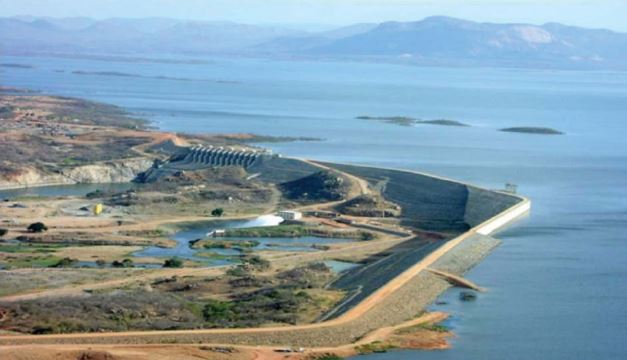
Source: DNOCS, 2009.
Figure 3. Aquaculture Parks in the Castanhão Dam—Ceará.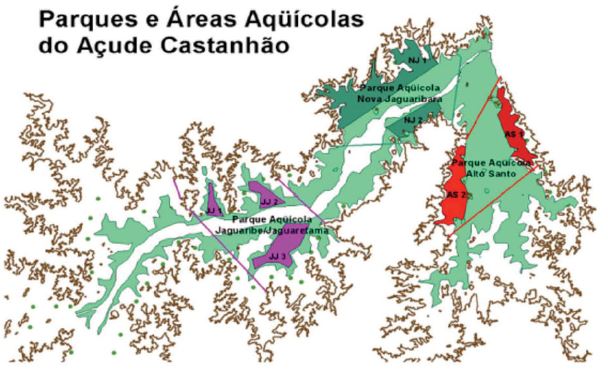
Source: MFA, 2012.
Figure 4. Tilapia cultivation centers in the Aquaculture Parks in the Castanhão Dam.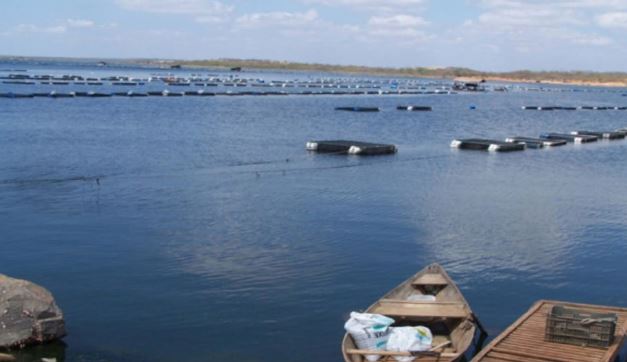
Source: Osvaldo Segundo, 2011.
than 680 cultivation areas and capacity to produce 32 000 tonnes of fish per year.
In 2008, the MFA granted the usage rights of physical spaces in the Federal Union waters for fish farming purposes in these parks. Figure 4 depicts the cultivation of tilapia fish in one of the dam’s aquaculture parks.
The Elaboration of Sustainability Indexes
Social Sustainability Sub-Index (SSS)
Among the five variables that compose this sub-index: the illiteracy rate (among people aged 15 years or more) was above average and the percentage of adults (15 years and older) having finished their primary education was below the average; which made these two variables yield the lowest “score.”
The other three variables: percentage of households with adequate water supply, percentage of households with access to the sewage collection network and average family income per capita in reais, were above the average; which made these three variables yield the highest “score.”
The social sustainability of fish farming in aquaculture parks in Castanhão-Ceará sub-index was 3.4, which qualifies as a medium social sustainability score and had five weighting for purposes of calculating the aquaculture sustainability index. This sub-index shows medium sustainability and suggests, with regard to training and identifying the social profile, that aquaculture was of crucial importance, with all variables yielding better results among the beneficiary group (already produces fish) than in the control group (still doesn’t produce fish).
But when it comes to variables that are inherent to the public service, it is possible to conclude that greater investments in social related aspects are greatly needed, especially in education.
Environmental Sustainability Sub-Index (SSA)
The sub-index of environmental sustainability of fish farming in cages in aquaculture parks in Castanhão-Ceará was 3.4, which qualifies as medium environmental ustainability, and weighting had four in the calculation of the final aquaculture sustainability index.
Among the five variables that compose this sub-index, the rational use of natural resources and the risk of eutrophication were below average, which made these two variables yield the minimum “score.” The other three variables: the existence of an environmental permit, the destruction of vegetation and the viability without electricity or fossil fuels were above the average, which meant that they stayed within the highest level of “score.”
This sub-index yielded a medium sustainability level, which proves that aquaculture is not of high environmental impact, but is influenced and influences the environment, as well as all other activities around the aquaculture system; whereas in most cases, other activities have greater environmental impact.
Economic Sustainability Sub-Index (SSE)
Among the five variables that compose this sub-index, all five variables (average price/cost of production, break-even point, net present value, “payback” and attractiveness rate) were above the average, which made these yield the highest level of “score.”
Thus, this sub-index of economic sustainability was rated 5.0. It is considered highly sustainable and had weight 2 in the calculation of the fin Aquaculture Sustainability Index. The economic sustainability sub-index yielded high sustainability results, which proves that an activity that generates alternative employment and income in poor and disadvantaged communities tends to have huge returns in quality of life for populations that are socially vulnerable.
Institutional Sustainability Sub-Index (SSI)
Among the five variables that compose this sub-index, the approval of investments was below average, which made this variable to yield the lowest “score” level.
The variable “execution of decisions made at the meetings” was on average, which made it yield an intermediate “score.”
The other three variables: active participation in the meetings, assessing the presented suggestions and participation in the choice of leaders were above average, which meant they yielded the highest “score” level (Annex 1).
Thus, the institutional sustainability sub-index was rated 3.8. It is considered of average sustainability level and had weight 3 in the final calculation of the Aquaculture Sustainability Index.
In this thesis, the institutional dimension was widely explored and the existence of two associative groups that have the power to build their own destinies and that see in aquaculture a way to improve their lives and that of their families was vehemently verified by the conducted case studies. However, this participation still lacks investments intended to strengthen and democratize the current management structures, having in mind the development of the territory in question.
Aquaculture Development Sustainability Index (IDSA)
Among the four sub-indexes that compose the Aquaculture Sustainable Development Index, the Social Sustainability Sub-Index (SSS) was rated 3.4; the Environmental Sustainability Sub-Index was 3.4; the Institutional Sustainability Sub-Index was rated 3.8 and the Economic Sustainability Sub-Index was 5.0. When we take into account the considerations made by local representatives, we had that the ADSI was equal to 3.71. It is therefore considered to be of medium sustainability. (Table 2).
• Unfortunately, after 5 years of the most strongest drought in 100 years and in a scenary of no management, no monitoring and no controlling by government agencies and local producers, the fish culture production in these aquaculture parks had two huge losses in 2015 and in 2016. We believe that it will need two or three years to be back, if it would be done in a sustainable way.
Table 2. Weighted elaboration of the ADSI. Thesis’ results.

The Cultivation of Oysters and Mussels in Marine Aquaculture Parks in the State of Santa Catarina, Brazil
Santa Catarina is the only Brazilian State where Marine Aquaculture Parks where implanted with a formal Monitoring Plan through the Agreement No. 17/2012 between the MFA and the State Agriculture and Fishing Secretary of Santa Catarina—SAR (SICONV 775438/2012) having been technically implemented by EPAGRI—Agricultural Research and Rural Extension Company of Santa Catarina. According to EPAGRI (2014), the first public tenders were held in 2011, and currently most of the aquaculture sites have already been granted to producers. Furthermore, most of the seawater fish farms established in Santa Catarina (Picture 1) were granted permits by the competent environmental agencies for the cultivation of mussels and oysters (Picture 2).
Picture 1. Marine Aquiculture Parks in the state of Santa Catarina, Brazil.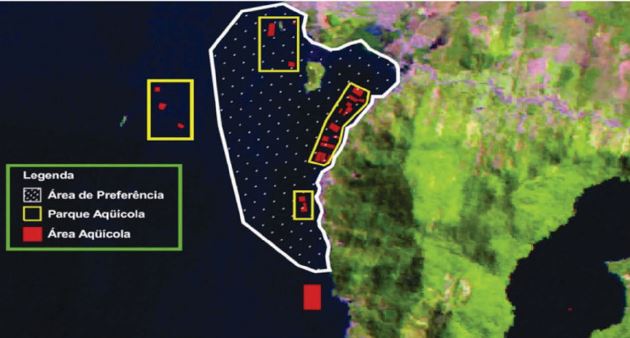
Picture 2. Oyster and mussels cultivation centre in Marine Aquiculture Parks in the state of Santa Catarina, Brazil.